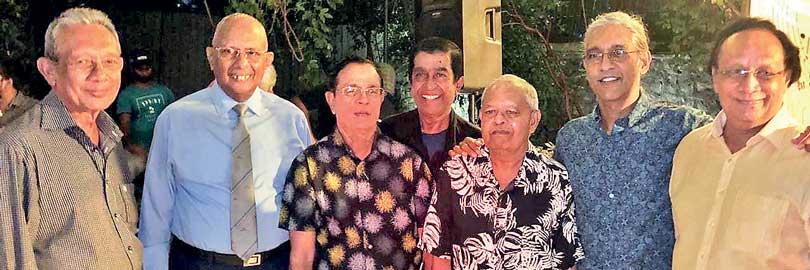01 Oct 2019 - {{hitsCtrl.values.hits}}

Vijaya Corea (2nd from left) and team at the Sooriya Show re-launch
 “It’s hard to remember just what that period was like,” Mick Jagger, speaking of the sixties, told an interviewer somewhere in the eighties.
“It’s hard to remember just what that period was like,” Mick Jagger, speaking of the sixties, told an interviewer somewhere in the eighties.
We remember the rebels, revolutionaries, and conformists, of course: Jack and Jackie and Bobby Kennedy, Syngman Rhee, Castro, Che, Ho Chi Minh, Sirimavo, and Chairman Mao. Then we remember the stars: Marilyn, Andy Warhol, the Crystals, the Monkees, Phil Spector, and Julie Andrews singing “Raindrops on Roses and Whiskers on Kittens” even as Pauline Kael called The Sound of Music the kind of movie that showed the kind of world we pretended we wanted to live in. The Beatles came later, as did the Rolling Stones. Where were we? We were somewhere there, a pear drop (or teardrop?) of an island in the middle of the Indian Ocean, with Vijaya Corea booming into Radio Ceylon and hosting a show that summed up all the paradoxes of that era. The Sooriya Show saw the light of day 50 years ago. 50 years later, here we are.
I know very little about the economics and mechanics of the music industry, even if it’s a small industry like ours. I do listen to music, though. And I appreciate.
The Sooriya Show was responsible for taking several of those stars whom we listen to, sing, and sometimes strum at parties, weddings, and Big Matches, beyond the conventional radio broadcast. On Saturday, September 28, the first Sinhala LP from the Sooriya Show was re-launched. Perhaps re-launched isn’t the best word. Re-release would be better. In any case, the Sooriya Show was the first LP on a Sri Lankan label. The label was Sooriya. And the re-release was at the Sooriya Village. There was conversation and music, and there was room for nostalgia. Vijaya Corea was there, as were Melroy Dharmaratne and Nadeeka Guruge; on one corner was Feizal Samath, and (literally) at the centre was the son of the pioneer who unleashed Sooriya on (and throughout) the country, Udena Wickremesooriya.
In an otherwise perceptive essay on the structure of baila and pop music in Sri Lanka, the renowned musicologist Anne Sheeran comments on two broad strands in the evolution of both genres: one that repudiated consumerism and one that embraced it. She teleports us from Wally Bastiansz and C. T. Fernando, who rejected Westernisation and consumerism in their lyrics, to M. S. Fernando, who celebrated a life of ease, opulence, and prodigality in theirs. The problem isn’t the dichotomisation, rather the basis for the dichotomisation: at no point was pop culture influenced by one set of overriding influences over another; that, in any case, was what I gathered from Udena, who argued that the motive of many pop music icons from that era was a passion to take forward the folk tunes of the country to the world.
The pop culture industry in Sri Lanka was stunted and, ironically, popularised by Radio Ceylon’s decision to impose a ban on all forms of undesirable (i.e. Western) music. As a result of the blanket ban (which amounted to censorship), groupies and bands influenced by an onslaught of Latin American (particularly from Paraguay and the most popular vocalist from there, Luis Alberto del Paraná) music took to hotels, labels, and the occasional show to exhibit their talents. The banjo, the mandolin, and the guitar became indisputable symbols, so much so that by the time Neville Fernando had entered the scene, the stage had been set for a flourishing pop renaissance. Not even cultural censorship could finish it off.
What is often forgotten is that it wasn’t just Western music that was banned from Radio Ceylon; it was also any genre that wasn’t influenced and shaped by North Indian Hindustani music. In other words, it wasn’t just the likes of C. T. Fernando who had to pay the price for their versatility (C. T., as Tissa Abeysekara once observed, could never open up without the accompaniment of brass instruments), it was also Sunil Shantha, who in 1952 boycotted the auditions held by his teacher from Marris College of Music Bhatkhande, S. N. Ratanjankar, which vetted out composers and vocalists who fell outside his criteria; for the next 10 years, it was this criteria, Ratanjankar’s criteria, that decided the future of aspiring musicians. The irony was that in excluding Western songs along with folk music (in what other genre can we place Sunil Shantha’s works?), Radio Ceylon was bringing together two completely different forms. The pop singers who saw this jumped in, filled in the “lacuna” (as Vijaya Corea called it), and turned into exponents of a new kind of music, indeed of art: pop folk. The Sinhala service of Radio Ceylon (the oldest in South Asia) ignored and even denigrated thuppahi sangeethaya. But there was a mounting demand, a growing hunger, for what was being denigrated. Vijaya Corea saw the mismatch between demand and supply and he came up with the only solution anyone could come up with: he featured pop Sinhala on the English service. When Sooriya came onboard, and when it became the first Sri Lankan label to sell Sri Lankan pop music, Vijaya and Sooriya’s founder, Gerald Wickremesooriya, conspired and came up with a nine o’clock show (and LP record) to beat them all. This was the Sooriya Show. Since the list of names who found an outlet for their sensibilities through the Show is too exhaustive, I won’t mention them here; suffice it to say that, as Udena put it, “the Sooriya Show, and indeed Sooriya, would have been nowhere without Vijaya Corea.”
Melroy Dharmaratne took us through some of the ditties he wrote, composed, and sang with his brothers. He talked about “Sakalabujan” (which, Udena remembered, was banned by the then government). He pointed out that the hero of the song was, in real life, a fully grown, do-it-all, dependable servant “who was always there.” He talked about the first Dharmaratne Brothers single, “Wassa Wahinawa”, and how he reflected on everything he saw in the streets of Kotahena when it poured (including “Jamis aiyage kade”, which would close whenever it started thundering). He contended that contrary to what most people thought, pop music in Sri Lanka was never urbanised, and was shaped by a rural culture. Not many will subscribe to that view, but it’s true: almost every pop song, from “Mango” to “Kalu Mame”, was about villagers, “their lives, their loves, their hopes, and so on” as Melroy put it. The youngest in the panel that night, Nadeeka Guruge was probably the most forthright. In response to an observation by Feizal Samath that baila and pop music in Sri Lanka was shaped by Portuguese music, he argued that we have overstated the Portuguese influence in local pop music: “Even in other parts of the world colonised by them,” he said, “we come across musical instruments that have no real colonial connection.”
This of course went against the conventional wisdom that there are historic links between the Portuguese and Sinhala pop, as did Nadeeka’s other view, a response to an argument by Priya Peiris, that trends and tastes (seen to have deteriorate from the 1960s) should be placed in the context against which they evolved; given this, Priya’s view that contemporary bands tend to resort to the electric guitar “because that is all they can use and overkill” misses the fact that the electric guitar has become THE symbol of modern urban youth.
Priya Peiris (who spoke about the genesis of “Kale Ukula Thiyala” and “Cock-a-Doodle” while casually bantering with Udena) said that while there’s no point taking potshots at this or that band or group today, nevertheless the fact remains that “in our time, members stuck by each other even if petty arguments and tussles threatened to keep them apart.” That sense of unity and diversity seems to be missing in today’s musical sphere, something which Melroy talks about, or rather touches upon, when he subjects two otherwise must-listen-to eighties songs, “Oye Ojaye” and “Uncle Johnson”, both by the Gypsies, to criticism in his anthology; between the Dharmaratne Brothers and the Gypsies, there is a gulf that can be explained, in part at least, by the debasement of cultural standards after the late seventies.
“The Sooriya Show” came before all that. It was a different period. Certainly a kinder period. And for two hours, on a soggy Saturday evening, I lived through the magic of it.
02 Jan 2025 02 Jan 2025
02 Jan 2025 02 Jan 2025
02 Jan 2025 02 Jan 2025
02 Jan 2025 02 Jan 2025